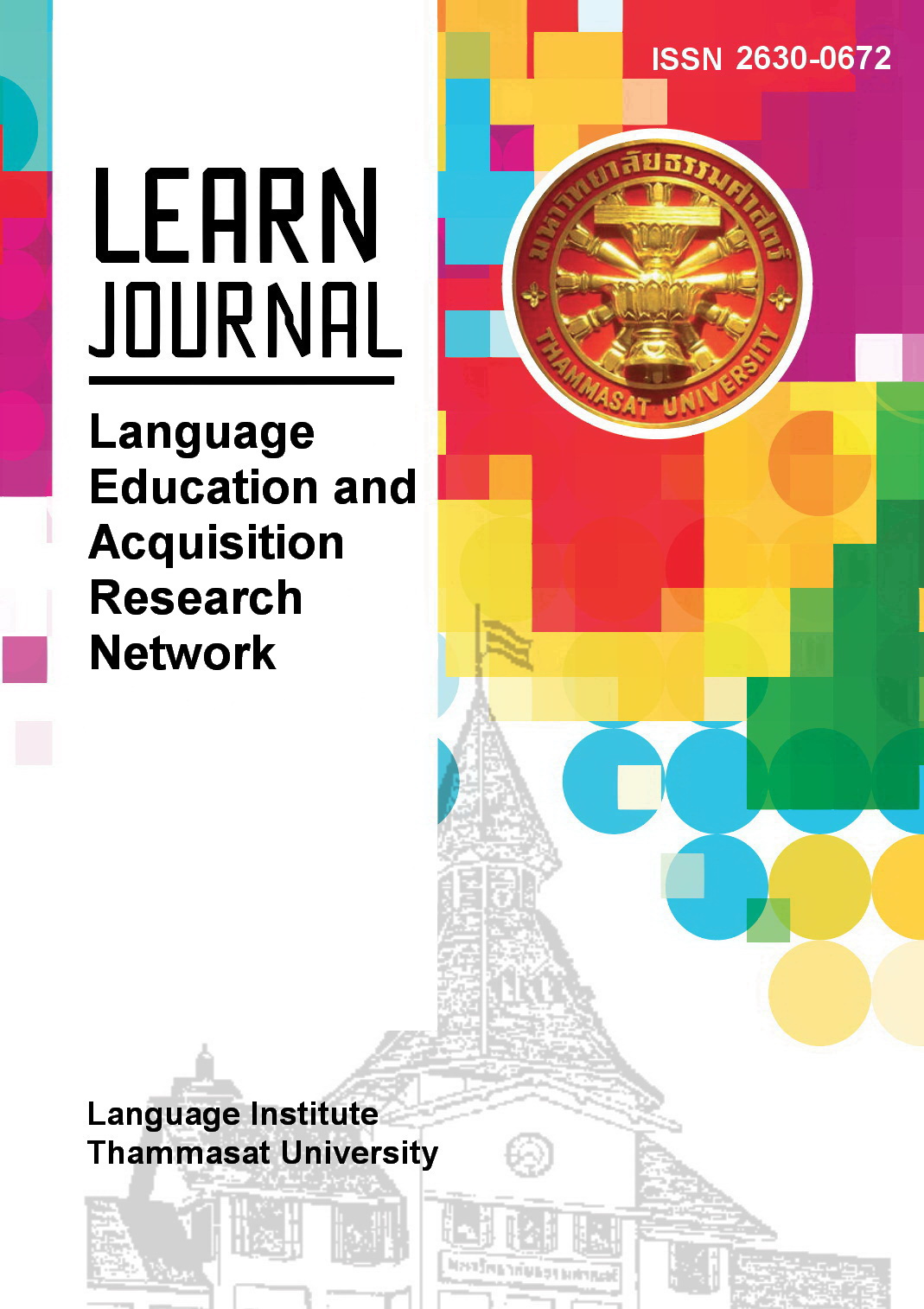A Diachronic Corpus-Based Analysis of LGBTQ-Related Research Articles
Main Article Content
Abstract
This study uses a diachronic corpus-based analysis to explore the topics presented in LGBTQ-related research articles published between 2001 and 2020, and to examine diachronic changes in these topics over time. The data are from 400 LGBTQ-related research articles which are divided into four time periods (2001-2005, 2006-2010, 2011-2015, 2016-2020) with 100 articles per period. We analyzed the data by looking at keywords, comparing keywords across time, and investigating the concordance lines. The findings from the keywords analysis revealed thirteen LGBTQ-related topics: sexuality, gender, relationship, hate, research, theory, culture, socio-politics, standard, science, place, sport, and nationality. The findings from the comparison across the four time periods show the diachronic changes in topics by looking at keywords identified as always key, previously key, and recently key. The concordance lines show in-depth investigation of the topics to discuss about LGBTQ. The in-depth investigation of the concordance lines indicates that LGBTQ people have difficulty in coming out due to traditional values. This analysis of LGBTQ-related research articles provides new insights into the way LGBTQ people are discussed which can be useful for further studies regarding application of a methodological framework to investigate LGBTQ-related topics in other types of data sources.
Article Details
References
Anthony, L. (2022). AntConc (Version 4.1.4) [Computer Software]. Waseda University. Available from https://www.laurenceanthony.net/software/antconc/
Baider, F. (2018). “Go to hell fucking faggots, may you die!” framing the LGBT subject in online comments. Lodz Papers in Pragmatics, 14(1), 69–92. https://doi.org/10.1515/lpp-2018-0004
Baker, P. (2013). From gay language to normative discourse. Journal of Language and Sexuality, 2(2), 179-205. https://doi.org/10.1075/jls.2.2.01bak
Baker, P. (2014). Using corpora in discourse analysis. Bloomsbury Academic
Biber, D., & Reppen, R. (2015). The Cambridge handbook of English corpus linguistics. Cambridge University Press.
Cislaghi, B., & Heise, L. (2020). Gender norms and social norms: Differences, similarities and why they matter in prevention science. Sociology of Health & Illness, 42(2), 407-422.
https://doi.org/10.1111/1467-9566.13008
Cohen, Y. (2017). Estimating the intra-rater reliability of essay raters. Frontiers in Education, 2, 1-11. https://doi.org/10.3389/feduc.2017.00049
De Witte, K., Iterbeke, K., & Holz, O. (2019). Teachers’ and pupils’ perspectives on homosexuality: A comparative analysis across European countries. International Sociology, 34(4), 471-519. https://doi.org/10.1177/0268580919854295
Eichler, M. A. (2010). Joining the family: Experiences of being and becoming ally activists of LGBTQ people. Journal of Transformative Education, 8(2), 89-102. https://doi.org/10.1177/1541344611406904
Gabrielatos, C., & Baker, P. (2008). Fleeing, sneaking, flooding. Journal of English Linguistics, 36(1), 5-38. https://doi.org/10.1177/0075424207311247
Goldberg, A. E., & Allen, K. R. (2018). Teaching undergraduates about LGBTQ identities, families, and intersectionality. Family Relations, 67(1), 176-191. https://doi.org/10.1111/fare.12224
Institute of Medicine of the National Academies. (2011). The health of lesbian, gay, bisexual, and transgender people: Building a foundation for better understanding. National Academies Press.
Jones, L., & Collins, L. (2020). PrEP in the press. Journal of Language and Sexuality, 9(2), 202-225. https://doi.org/10.1075/jls.20002.jon
Kollmayer, M., Schober, B., & Spiel, C. (2018). Gender stereotypes in education: Development, consequences, and interventions. European Journal of Developmental Psychology, 15(4), 361-377. https://doi.org/10.1080/17405629.2016.1193483
Kuvalanka, K. (2013). The “second generation”: LGBTQ youth with LGBTQ parents. In A. Goldberg & K. Allen (Eds.), LGBT-Parent Families (pp. 163-175). https://doi.org/10.1007/978-1-4614-4556-2_11
Lev, A. I. (2010). How queer!-the development of gender identity and sexual orientation in LGBTQ-headed families. Family Process, 49(3), 268-290. https://doi.org/10.1111/j.1545-5300.2010.01323.x
Lewis, M. M., & Kern, S. (2018). Using education law as a tool to empower social justice leaders to promote LGBTQ inclusion. Educational Administration Quarterly, 54(5), 723-746. https://doi.org/10.1177/0013161x18769045
Longman Dictionary of Contemporary English. (n.d.) https://www.ldoceonline.com/
Love, R., & Baker, P. (2015). The hate that dare not speak its name? Journal of Language Aggression and Conflict, 3(1), 57-86. https://doi.org/10.1075/jlac.3.1.03lov
Mekler, A. G. (2018). LGBTIQ (in)visibility: A human security approach to SOGIESC. In C. L. Mason (Ed.), Routledge handbook of queer development studies (pp. 155-168). Routledge.
Nelson, T. R. (2015, April 10). A movement on the Verge: The spark of Stonewall [Paper presentation]. MAD-RUSH Undergraduate Research Conference, Harrisonburg, VA, United States.
Pojanapunya, P., & Watson Todd, R. (2018). Log-likelihood and odds ratio: Keyness statistics for different purposes of keyword analysis. Corpus Linguistics and Linguistic Theory, 14(1), 133-167. https://doi.org/10.1515/cllt-2015-0030
SAGE. (n.d.). About us — SAGE publishing. https://group.sagepub.com/about
Santonocito, C. S. (2020). LGBT* people in the speeches of Italian and British PMs: A corpus-assisted critical discourse analysis. Critical Approaches to Discourse Analysis across Disciplines, 11(2), 187–212.
Wang, G., & Ma, X. (2020). Representations of LGBTQ+ issues in China in its official English-language media: A corpus-assisted critical discourse study. Critical Discourse Studies, 18(2), 188–206. https://doi.org/10.1080/17405904.2020.1738251
Wilkinson, M. (2022). Radical contingency, radical historicity and the spread of ‘homosexualism’: A diachronic corpus-based critical discourse analysis of queer representation in the times between 1957-1967 and 1979–1990. Discourse, Context & Media, 48, 1-9.
https://doi.org/10.1016/j.dcm.2022.100623
Zottola, A. (2018). Transgender identity labels in the British press. Journal of Language and Sexuality, 7(2), 237-262. https://doi.org/10.1075/jls.17017.zot


